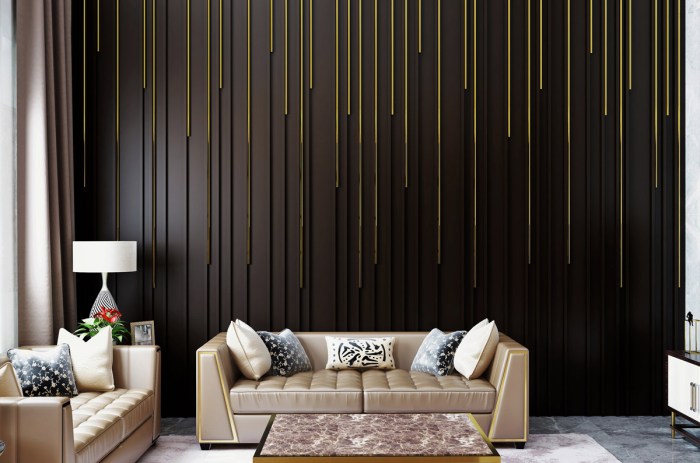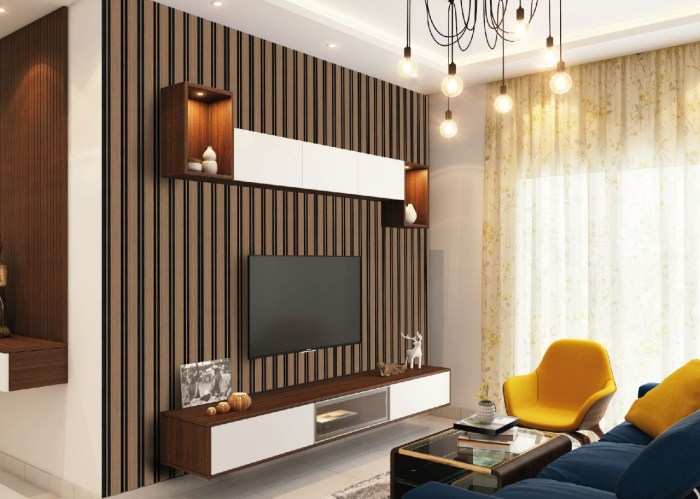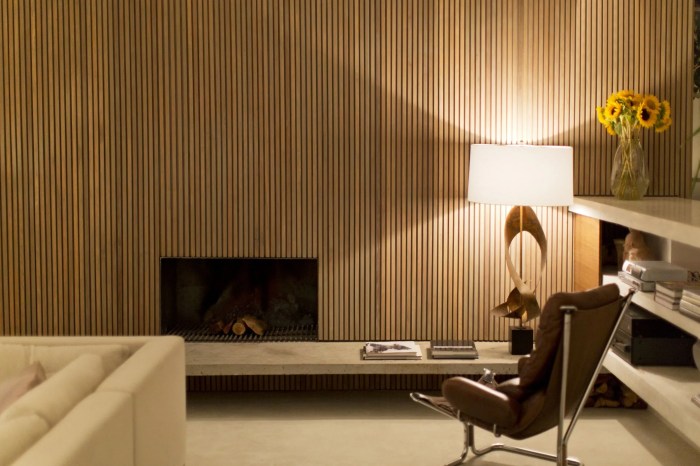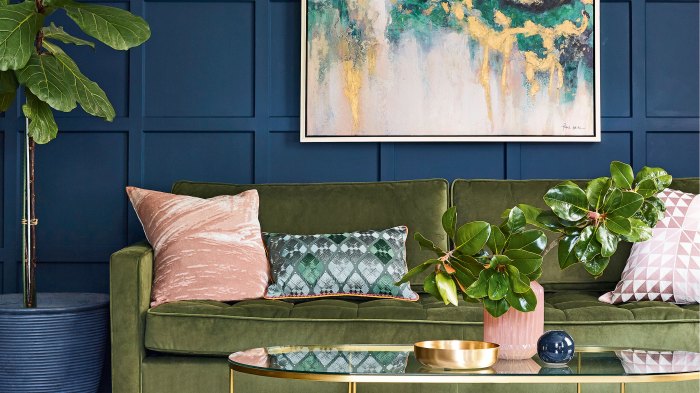Living room wall panelling ideas – Step into the world of living room wall paneling ideas, where creativity meets functionality. From classic wainscoting to modern shiplap, discover a myriad of design concepts that will elevate your living space. Get ready to explore a symphony of colors, textures, and patterns, as we delve into the art of transforming walls into captivating masterpieces.
Unleash your inner designer and embark on a journey of inspiration, where every panel tells a story. Whether you seek timeless elegance or contemporary flair, this guide will empower you to create a living room that reflects your unique style.
Design Ideas for Paneling
Wall paneling has gained popularity as a sophisticated and versatile design element in living rooms. It offers a range of options to enhance the aesthetics, create focal points, and introduce texture and depth into the space.
Design concepts for wall paneling vary widely, encompassing traditional, modern, and eclectic styles. Traditional paneling often features intricate moldings and carvings, adding an air of elegance and formality to the room. Modern paneling, on the other hand, favors clean lines and geometric patterns, creating a sleek and contemporary look.
Eclectic paneling combines elements from different styles, resulting in a unique and personalized space.
Paneling Patterns
The choice of paneling pattern significantly influences the overall look of the living room. Some popular patterns include:
- Wainscoting:Wainscoting involves paneling the lower portion of the wall, typically up to chair rail height. It adds a touch of sophistication and can help protect the wall from damage.
- Shiplap:Shiplap panels are horizontal planks that overlap slightly, creating a rustic and cozy atmosphere. They are commonly used in coastal and farmhouse-style homes.
- Board and Batten:Board and batten paneling consists of vertical boards with narrow battens covering the seams. This pattern adds a touch of texture and dimension to the wall.
Paneling Materials
The choice of paneling material depends on factors such as durability, aesthetic appeal, and budget. Popular options include:
- Wood:Wood is a classic choice for paneling, offering warmth, natural beauty, and durability. It comes in a variety of species, each with its own unique grain and color.
- MDF (Medium-Density Fiberboard):MDF is an engineered wood product that is durable, moisture-resistant, and affordable. It is available in a range of finishes, making it a versatile option.
- PVC (Polyvinyl Chloride):PVC is a synthetic material that is lightweight, moisture-proof, and easy to maintain. It is often used in areas with high humidity, such as bathrooms and kitchens.
Color and Finish Options
When it comes to living room wall paneling, color and finish play a crucial role in shaping the overall ambiance. Explore a myriad of color schemes, from serene neutrals to vibrant hues, each with its unique impact on the space.
Neutral Hues
Neutral shades, such as white, cream, or gray, provide a timeless backdrop for your living room. They exude elegance, create a sense of spaciousness, and serve as a versatile canvas for any decor style.
Bold Hues
If you desire a bolder statement, consider incorporating rich hues like navy blue, emerald green, or deep red. These colors create a dramatic focal point, add warmth and depth, and can transform your living room into a cozy and inviting retreat.
Finishes
The finish you choose for your wall paneling can significantly alter its appearance and feel. Paint offers a smooth and polished look, while stain enhances the natural wood grain, creating a rustic or traditional ambiance. Wallpaper, on the other hand, introduces patterns and textures, adding visual interest and a touch of personality to your space.
Textures and Patterns
Incorporate textures and patterns into your paneling to add depth and visual interest. Raised panels, beadboard, or shiplap can create a dimensional effect, while geometric or floral patterns can bring a touch of elegance or whimsy to your living room.
Functional Benefits of Paneling
Wall paneling offers not only aesthetic appeal but also a range of practical advantages that enhance the functionality and comfort of living rooms.
Paneling effectively absorbs sound, reducing noise levels and creating a more peaceful ambiance. It also provides insulation, helping to regulate room temperature and reduce energy costs. Additionally, paneling protects walls from damage caused by furniture, children, or pets, preserving their pristine condition.
Concealing Wires and Cables
Paneling offers a convenient solution for concealing unsightly wires and cables, creating a clean and organized appearance. By routing wires behind panels, you can eliminate clutter and maintain a visually pleasing environment.
Creating Built-in Storage
Paneling can be strategically installed to incorporate built-in storage solutions. Recessed shelves, drawers, or cabinets can be seamlessly integrated into paneling, providing ample storage space for books, décor, or other items.
DIY Paneling Techniques: Living Room Wall Panelling Ideas

Whether you’re a seasoned DIYer or just starting out, installing wall paneling is a project that can be completed with a little planning and effort. Here’s a step-by-step guide to help you get started:
Materials and Tools Required
* Wall panels
- Nails or screws
- Adhesive
- Measuring tape
- Level
- Saw
- Hammer or drill
- Nail gun (optional)
Methods for Attaching Panels to Walls
There are three main methods for attaching panels to walls:* Nailing:This is the most traditional method and involves using nails to secure the panels to the wall studs.
Screwing
This method is similar to nailing, but uses screws instead of nails. Screws provide a more secure hold, but they can also be more difficult to remove.
Adhesive
This method is less invasive than nailing or screwing, but it is not as strong. Adhesive is best used for lightweight panels or for attaching panels to walls that are not in good condition.
Cutting and Fitting Panels
Once you have chosen a method for attaching the panels, you need to cut them to fit the wall. To do this, measure the wall and mark the cuts on the panels. Use a saw to cut the panels, and then use a level to make sure they are straight.
Installing the Panels
Once the panels are cut, you can begin installing them on the wall. Start by attaching the bottom row of panels. Use a level to make sure they are straight, and then secure them to the wall using nails, screws, or adhesive.Once
the bottom row is installed, you can continue installing the rest of the panels. Work your way up the wall, attaching each panel to the one below it.
Tips for a Seamless Finish
* Use a level to make sure each panel is straight before securing it to the wall.
- Use a nail gun to make the installation process faster and easier.
- If you are using adhesive, apply it evenly to the back of the panel.
- Allow the adhesive to dry completely before using the wall.
Cost Considerations and Budget Planning

Planning for the cost of wall paneling is crucial to ensure your project stays within your budget. Several factors affect the overall cost, including the materials, labor, and installation.
To budget effectively, consider the size of the room, the complexity of the design, and the materials used. More extensive rooms and intricate designs will require more materials and labor, increasing the cost.
Material Costs, Living room wall panelling ideas
- Wood:Natural wood paneling, such as oak or mahogany, is a durable and aesthetically pleasing option but can be expensive.
- Engineered wood:MDF (medium-density fiberboard) or plywood are cost-effective alternatives to natural wood, offering similar durability and a wide range of finishes.
- PVC (polyvinyl chloride):PVC panels are waterproof and resistant to moisture, making them suitable for areas like bathrooms or kitchens.
Labor Costs
- Installation:Hiring a professional installer will ensure a precise and high-quality finish but will add to the overall cost.
- DIY:Installing the panels yourself can save on labor costs but requires basic carpentry skills and time commitment.
Cost-Saving Measures
- Less expensive materials:Opt for engineered wood or PVC panels instead of natural wood to reduce material costs.
- DIY installation:Take on the installation yourself to eliminate labor costs, but ensure you have the necessary skills and tools.
- Simple designs:Choose simpler paneling designs with fewer intricate details to reduce labor time and material waste.
Lighting and Paneling Combinations
Lighting plays a crucial role in accentuating the beauty of wall paneling, creating distinct moods and atmospheres. By incorporating natural light, ambient lighting, and accent lighting, you can highlight the intricate details, textures, and colors of the paneling, transforming your living room into a visually captivating space.
Natural Light
Natural light is the most flattering source of illumination for wall paneling. Large windows or skylights allow ample sunlight to stream into the room, casting soft, diffused light that enhances the natural grain and texture of the wood. Position your paneling strategically to take advantage of natural light, creating a warm and inviting ambiance.
Ambient Lighting
Ambient lighting provides general illumination throughout the room, creating a comfortable and functional space. Overhead fixtures, such as chandeliers or recessed lighting, distribute light evenly, ensuring that the entire wall is well-lit. Choose fixtures that complement the style and color of the paneling to create a cohesive look.
Accent Lighting
Accent lighting is used to highlight specific features or areas of the wall paneling. Picture lights, sconces, or track lighting can be strategically placed to draw attention to intricate carvings, moldings, or artwork displayed on the paneled wall. By directing light onto these focal points, you can create visual interest and depth, enhancing the overall impact of the paneling.
Accessories and Decor for Paneled Walls
Wall paneling provides a sophisticated backdrop for your living room, but accessories and decor can take the design to the next level. By carefully selecting pieces that complement the paneling, you can create a cohesive and visually appealing space that reflects your personal style.
Artwork
Artwork is a great way to add color, texture, and interest to a paneled wall. Choose pieces that complement the color and style of the paneling, and hang them at eye level for maximum impact. Consider using a gallery wall arrangement to create a focal point or to showcase a collection of smaller pieces.
Mirrors
Mirrors can help to reflect light and make a room feel larger. They can also be used to create a sense of symmetry or to draw attention to a particular feature of the room. When placing mirrors on a paneled wall, be sure to consider the size and shape of the mirror in relation to the paneling.
Shelves
Shelves are a functional and stylish way to display books, collectibles, and other decorative items. Choose shelves that are made from a material that complements the paneling, and be sure to consider the weight of the items you plan to display when selecting shelves.
Other Decorative Elements
In addition to artwork, mirrors, and shelves, there are a number of other decorative elements that can be used to complement a paneled wall. These include:
- Wall sconces
- Tapestries
- Plants
- Pillows
- Throws
When selecting decorative elements for a paneled wall, it is important to consider the overall style of the room. Choose pieces that complement the paneling and that reflect your personal taste.
Case Studies and Inspiration

Discover real-life transformations with inspiring case studies of living rooms featuring stunning wall paneling. See how this design element can elevate your space, from traditional to modern styles.
Explore the choices of materials, patterns, and finishes used in these case studies, gaining insights into the transformative impact of wall paneling on the overall ambiance and functionality of the living room.
Before and After Comparisons
Witness the dramatic difference wall paneling can make through before-and-after comparisons. Visualize how this design technique can revamp your living room, enhancing its style and sophistication.
- Showcase examples of living rooms with dull and uninspiring walls transformed into elegant and inviting spaces with the addition of wall paneling.
- Highlight the clever use of paneling to conceal imperfections, add depth, and create a focal point in the room.
- Discuss how paneling can instantly upgrade the overall aesthetic, making a small living room feel more spacious or a large room more cozy and intimate.
Current Trends and Innovations
Wall paneling is experiencing a resurgence in popularity, with homeowners embracing its versatility and aesthetic appeal. Emerging trends include the use of innovative materials, such as reclaimed wood, metal, and even fabric, to create unique and eye-catching designs.
Design styles are also evolving, with a move towards contemporary and minimalist aesthetics. Clean lines, geometric patterns, and neutral colors are becoming increasingly popular, reflecting a desire for simplicity and sophistication.
Sustainable Materials
Sustainability is also playing a key role in wall paneling trends. Homeowners are opting for eco-friendly materials, such as bamboo, cork, and recycled wood, to reduce their environmental impact. These materials offer not only aesthetic appeal but also durability and soundproofing benefits.
Conclusive Thoughts

As you conclude this exploration of living room wall paneling ideas, may your creativity soar. Remember, your walls are a canvas upon which you can paint a masterpiece. Embrace the transformative power of paneling and let your imagination run wild.
The possibilities are endless, so dive in and create a living space that truly reflects your vision.
Quick FAQs
What are the benefits of using wall paneling in a living room?
Wall paneling offers numerous advantages, including sound absorption, insulation, protection against wall damage, and the ability to conceal wires and cables, creating a clean and organized appearance.
How do I choose the right color and finish for my wall paneling?
Consider the overall ambiance you want to create. Neutral hues provide a timeless backdrop, while bolder colors can add a touch of drama. Explore different finishes such as paint, stain, or wallpaper to enhance the aesthetic appeal and texture of your paneling.
Can I install wall paneling myself?
Yes, DIY wall paneling installation is possible with the right tools and materials. Follow step-by-step instructions carefully, and don’t hesitate to seek professional assistance if needed.


